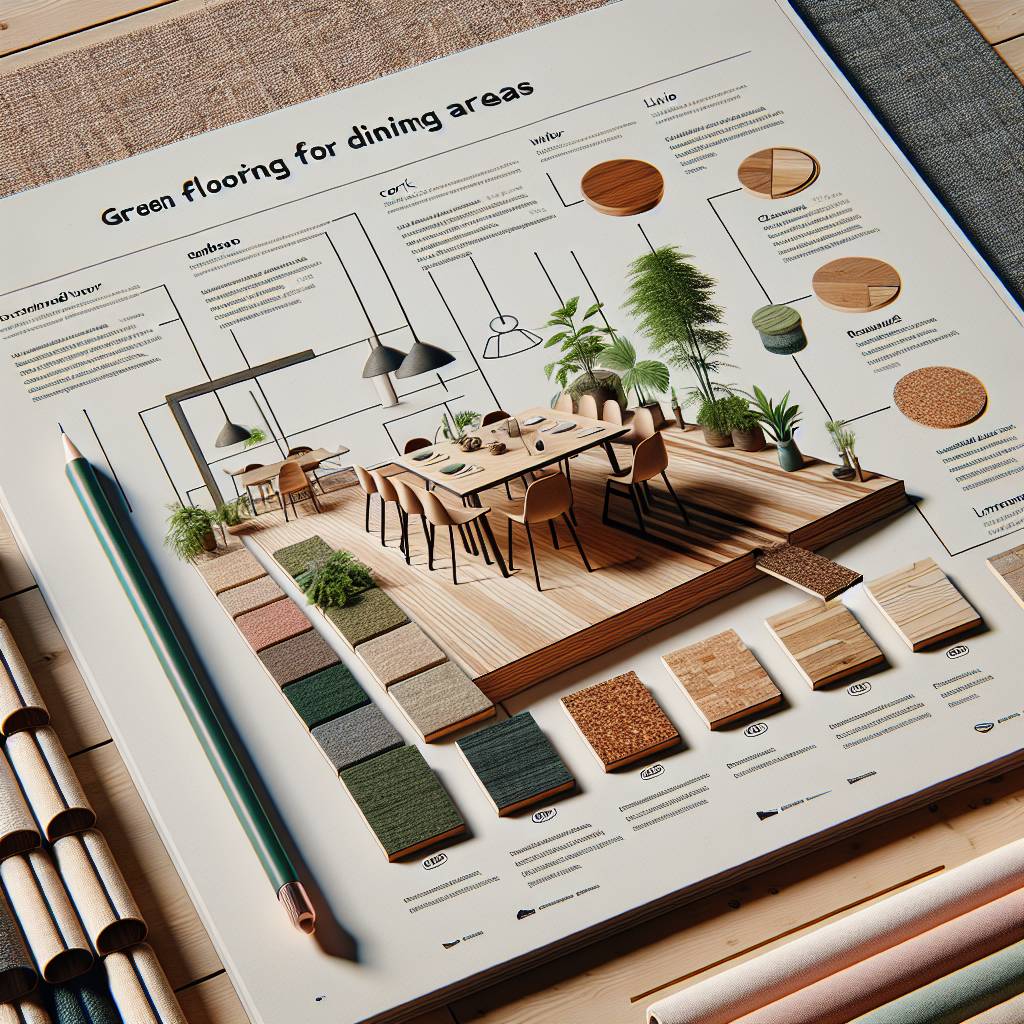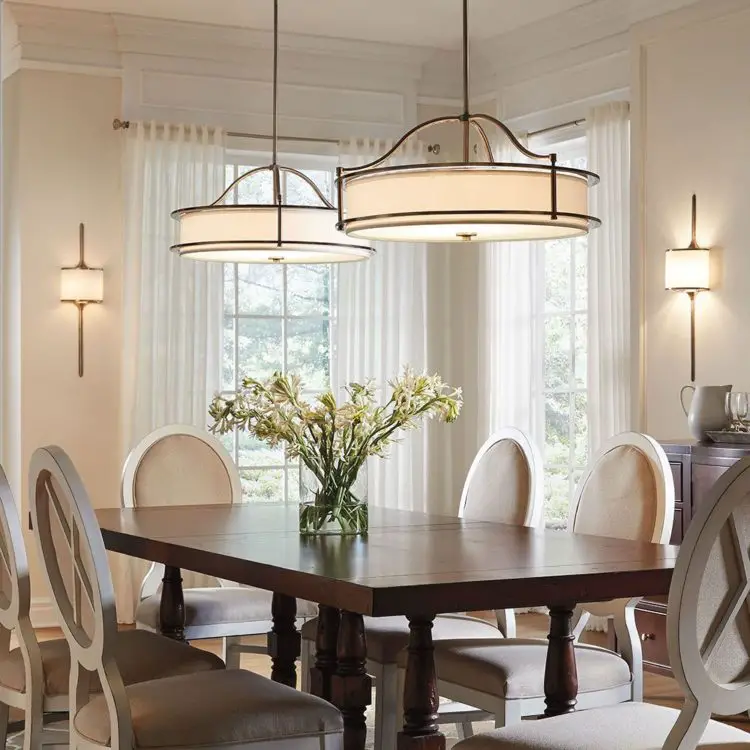Looking to revamp your dining area with eco-friendly flooring? You’re in the right place!Choosing the right flooring is crucial. In this guide, we’ll delve into a variety of green flooring options suited for dining areas. From classic hardwood, bamboo, cork, and reclaimed wood, to innovative carpeting, rugs, and floor product, there’s a myriad of environmentally conscious choices available. We’ll explore the benefits of each option, including durability, maintenance, and aesthetic appeal. Whether you’re aiming for a rustic charm or contemporary elegance, these green flooring solutions in the eco-friendly dining room offer versatility without compromising on environmental impact.
Key Takeaways
- Choose sustainable flooring materials like bamboo, cork, or reclaimed wood to reduce environmental impact and create a healthier dining area.
- Prioritize eco-friendly flooring options to benefit from improved indoor air quality, reduced energy consumption, and lower maintenance requirements.
- Consider natural fiber carpeting and terrazzo as sustainable design choices for dining areas, promoting a stylish yet environmentally conscious space.
- Avoid rubber and PVC plastic flooring alternatives due to their negative environmental impact and potential health risks.
- Regularly maintain eco-friendly floors using gentle cleaning methods and non-toxic products to prolong their lifespan and preserve their sustainability.
- Make cost-effective decisions by selecting durable, long-lasting green flooring products that offer both environmental benefits and economic savings.
Overview of Eco-Friendly Flooring Options
Wide Range
There is a wide range of materials available, each with its own unique characteristics and benefits. You can choose from sustainable materials such as bamboo, cork, reclaimed wood, or even recycled metal tiles. These options not only offer durability but also contribute to the reduction of environmental impact.
Eco-friendly flooring options are designed to minimize harm to the environment while providing a healthy indoor space. For instance, bamboo is a popular choice due to its rapid growth, renewability, and cons. It’s an excellent alternative to traditional hardwood floors because it matures in just five years compared to standard trees that take decades.
Cork is another fantastic option known for its natural insulating properties and softness underfoot. This material is harvested from the bark of cork oak trees without causing any harm to them. Furthermore, using reclaimed wood from old barns or factories reduces the need for new timber harvesting while adding character and history to your dining area.
Benefits
The use of eco-friendly flooring options in your dining area offers several benefits beyond sustainability. These materials often require minimal maintenance and cleaning due to their natural resistance against moisture and stains. They can improve indoor air quality by reducing harmful emissions commonly found in synthetic flooring products.
By opting for sustainable flooring options, you’re not only making an environmentally conscious decision but also enhancing the aesthetic appeal of your dining area. The natural textures and colors offered by green flooring materials add warmth and character that complements various interior design styles.
Choosing eco-friendly flooring option means minimizing your carbon footprint while creating a healthier living environment for you and your family members.
Benefits of Choosing Sustainable Flooring
Environmental Impact
Choosing green flooring options for dining areas can significantly reduce the environmental impact. These sustainable materials are often made from renewable resources, such as bamboo or cork, which helps in conserving natural resources and reducing carbon footprint. By opting for eco-friendly flooring, you contribute to the preservation of forests and other ecosystems.
Sustainable flooring also minimizes the release of harmful chemicals into the environment. Unlike traditional flooring materials that may contain volatile organic compounds (VOCs), green flooring options are manufactured without toxic substances, thereby promoting a healthier planet.
Indoor Air Quality
One of the most significant benefits of sustainable flooring in dining areas is its positive effect on indoor air quality. Eco-friendly materials do not emit harmful gases that can compromise air quality within enclosed spaces like dining rooms. This reduction in airborne toxins creates a safer and healthier environment for individuals who spend time in these areas.
In contrast, non-sustainable flooring materials can release VOCs over time, contributing to poor indoor air quality and potential health issues for occupants. By choosing green alternatives such as reclaimed wood or natural linoleum, you ensure that your dining area maintains clean and fresh air without compromising on aesthetics or functionality.
Longevity and Cost-Efficiency
Opting for sustainable flooring options offers long-term benefits due to their durability and longevity. Many environmentally friendly materials have a longer lifespan compared to conventional ones, reducing the need for frequent replacements. For instance, bamboo floors are known for their exceptional durability while being an aesthetically pleasing choice for dining areas.
Top Eco-Friendly Flooring Materials for Your Home
Bamboo Flooring
Bamboo flooring is an excellent flooring material for dining areas due to its eco-friendly nature. It’s derived from a fast-growing plant, making it a highly renewable resource. Bamboo is incredibly durable, perfect for withstanding the traffic and potential spills common in dining spaces. For example, if you accidentally drop a plate or glass on bamboo flooring, it’s less likely to incur damage compared to other materials.
Moreover, bamboo has natural resistance to moisture and insects, making it an ideal choice for areas like dining rooms where food and drinks are frequently present. This means you won’t have to worry as much about water damage or pest infestations over time.
Cork Flooring
Cork flooring is another fantastic flooring material option known for its sustainability and insulation properties. When used in dining areas, cork provides excellent thermal insulation that can help reduce energy consumption by maintaining the room’s temperature more effectively. This not only creates a comfortable environment but also contributes to lower energy bills.
Furthermore, cork is made from the bark of cork oak trees without harming them; this makes it one of the most sustainable options available. Its shock-absorbent nature also adds an extra layer of comfort underfoot while reducing noise levels caused by foot traffic or moving chairs around the dining table.
Reclaimed Wood Flooring
Reclaimed wood flooring offers a unique charm while being environmentally friendly at the same time. By utilizing salvaged materials from old buildings or structures, reclaimed wood helps reduce deforestation by giving new life to existing resources. In addition to its environmental benefits, reclaimed wood brings character and history into your home through its distinct markings and imperfections.
In terms of practicality in dining areas, reclaimed wood is exceptionally durable and can withstand heavy use without losing its appeal over time. Spills or stains can often add character rather than causing permanent damage because they blend into the existing patina of the wood.
Rubber and PVC Plastic as Green Flooring Alternatives
Rubber Flooring: Eco-Friendly and Durable
Rubber flooring, crafted from recycled tires, is an eco-friendly choice for dining areas. Its durability and low maintenance make it a practical option for high-traffic spaces. The use of recycled materials in its production reduces waste while providing a reliable surface for dining areas.
Rubber flooring’s resistance to moisture and stains makes it easy to clean, ideal for busy dining spaces where spills are common. This sustainable option not only contributes to environmental conservation but also offers long-term cost savings due to its longevity.
For instance:
- A restaurant looking for an environmentally friendly flooring solution might opt for rubber flooring in its dining area.
PVC Plastic Flooring: Versatile and Environmentally Conscious
When manufactured using recycled materials without harmful additives such as phthalates or formaldehyde, PVC plastic can be considered a green flooring alternative. This versatile material offers various design options suitable for different dining area styles.
By utilizing recycled content in the production of PVC plastic flooring, manufacturers reduce the demand for new petroleum-based resources. This process helps lower the environmental impact associated with traditional lumber or non-recycled plastics used in conventional flooring options.
For example:
- A sustainable-minded homeowner seeking an eco-conscious choice may select PVC plastic flooring made from recycled materials that align with their green living principles.
Natural Fiber Carpeting and Terrazzo in Sustainable Design
Natural Fiber Carpeting
Natural fiber carpeting, such as wool or sisal, presents a sustainable flooring option for dining areas. These materials are biodegradable and renewable, making them environmentally friendly. For instance, wool is known for its durability and natural insulating properties, providing both comfort and practicality in dining spaces. Sisal rugs offer a cozy and natural feel while being easy to maintain.
Utilizing natural materials like wool or sisal not only contributes to a more sustainable environment but also adds an organic touch to the design of dining areas. The use of these materials offers design possibilities that seamlessly blend with various interior styles while promoting an eco-friendly atmosphere.
Terrazzo Flooring
Terrazzo flooring stands out as another green option for dining areas due to its use of recycled materials like glass or stone chips embedded in concrete. This unique combination creates visually stunning floors with an array of colors and patterns. By incorporating recycled elements into its construction, terrazzo promotes sustainability by reducing waste while offering an aesthetically pleasing flooring solution.
In addition to its visual appeal, terrazzo provides excellent durability suitable for high-traffic dining areas. Its resilience against wear makes it a long-lasting choice that requires minimal maintenance over time. This aspect aligns with the principles of sustainable design by minimizing the need for frequent replacements or repairs.
Pros and Cons
Pros:
- Both natural fiber carpeting and terrazzo utilize organic compounds from renewable resources.
- They contribute to reducing environmental impact through their biodegradability and use of recycled materials.
- These options provide durable solutions ideal for high-traffic dining areas.
Cons:
- Natural fiber carpeting may require additional care when dealing with spills compared to other synthetic options.
- While terrazzo is highly durable, it can be more costly upfront due to its intricate installation process involving skilled labor.
Selecting the Right Eco-Friendly Flooring Products
Sustainability Certifications
When choosing green flooring options for dining areas, it’s crucial to consider sustainability certifications. For wood-based materials, look for the Forest Stewardship Council (FSC) certification. This ensures that the wood comes from responsibly managed forests, promoting environmental conservation and social responsibility. By selecting FSC-certified hardwood flooring, you contribute to the preservation of forests while enjoying a beautiful and sustainable dining area.
Another aspect of sustainability is recycling. Some eco-friendly flooring products are made from recycled materials, reducing waste and minimizing environmental impact. For instance, recycled glass tiles or reclaimed wood flooring offer an environmentally conscious way to enhance your dining space while supporting sustainable practices.
Low VOC Emissions
Indoor air quality is essential in any living space, including dining areas. When exploring friendly flooring options, prioritize those with low VOC (volatile organic compound) emissions. High levels of VOCs can negatively affect indoor air quality and pose health risks such as respiratory issues and headaches. Opting for low-VOC flooring products helps maintain a healthier environment in your home by minimizing exposure to harmful chemicals.
Some eco-friendly flooring options utilize natural materials that inherently improve air quality by reducing allergens and pollutants present in the indoor environment. Cork flooring, for example, not only has low VOC emissions but also contains suberin—a natural substance that repels insects while inhibiting mold growth—contributing to cleaner indoor air without compromising on style or comfort.
Durability and Maintenance
When investing in green floor options for your dining area, consider their durability and maintenance requirements. While certain products may be environmentally friendly initially, they may require frequent replacement due to wear and tear over time—resulting in more resources being used up than anticipated. On the other hand, some eco-friendly choices like bamboo or cork are known for their resilience against heavy foot traffic and spills—making them ideal for high-traffic areas like dining spaces. It’s important to select an option that not only aligns with your sustainability goals but also withstands the demands of daily use without excessive maintenance needs.
Cost-Effective Solutions for Green Flooring
Long-Term Savings
When considering green flooring options, it’s crucial to look beyond the initial cost. While some eco-friendly materials may have a higher upfront price, they often offer long-term savings. For instance, bamboo and cork flooring are durable and can last for decades with minimal maintenance. This longevity means you won’t need to replace the flooring frequently, saving money in the long run.
Choosing locally sourced or recycled materials is another way to cut costs associated with green flooring. By selecting materials that are readily available in your area or opting for recycled products, you can reduce transportation expenses. Using locally sourced materials supports the regional economy and minimizes the environmental impact of transportation.
DIY Installation
Another cost-saving strategy when implementing green flooring is to consider DIY installation for certain sustainable materials. Some eco-friendly options like interlocking tiles or click-and-lock planks are designed for easy installation without professional help. By taking on the installation process yourself, you can save on labor expenses while also having greater control over the quality of workmanship.
Best Practices for Maintaining Eco-Friendly Floors
Regular Maintenance
To keep green flooring options for dining areas in top condition, regular maintenance is crucial. You should sweep or vacuum the floors frequently to eliminate dirt and debris that might cause scratches or damage. This simple practice helps in preserving the natural beauty of eco-friendly flooring materials like hardwood floors.
It’s important to use non-toxic cleaning products specifically designed for eco-friendly flooring. These products help avoid chemical buildup and maintain the integrity of the floors. By using gentle, environmentally friendly cleaners, you can ensure that your green floors remain free from harmful substances while retaining their original luster.
Prevention Methods
Another effective way to maintain green flooring options is by placing doormats at entrances. These mats are essential as they prevent dirt and moisture from being tracked onto the floors, which ultimately prolongs their lifespan. The doormats act as a barrier against outdoor elements that could potentially harm your eco-friendly dining area floors.
In addition to these practices, it’s also advisable to implement a no-shoe policy within dining areas with eco-friendly flooring options such as hardwood. Encouraging guests and family members to remove their shoes before entering these spaces significantly reduces the amount of dirt and debris brought indoors.
Environmental Impact and Upkeep of Sustainable Flooring
Reduced Carbon Emissions
Sustainable flooring materials, such as bamboo, cork, or reclaimed wood, often require less energy-intensive manufacturing processes compared to traditional options. This means that during the production phase, these eco-friendly materials result in lower carbon emissions. For instance, bamboo grows rapidly and is ready for harvest in just a few years, making it an environmentally friendly choice for flooring. By choosing sustainable flooring options with low energy requirements for manufacturing, you can significantly reduce your carbon footprint.
When considering the environmental impact of sustainable flooring, it’s essential to focus on the entire lifecycle of the product. From extraction or harvesting to processing and disposal, each stage plays a role in determining its overall sustainability. For example, cork is harvested from the bark of cork oak trees without causing any harm to the tree itself. This sustainable practice ensures that new bark will grow back over time without damaging the tree or its environment.
Extended Lifespan and Minimized Waste Generation
Proper upkeep and maintenance of eco-friendly floors can extend their lifespan while minimizing waste generation over time. For instance, using area rugs or mats in high-traffic areas can protect sustainable floors from wear and tear caused by foot traffic or furniture movement. Regular cleaning with gentle products suitable for specific sustainable flooring materials can help maintain their appearance and structural integrity.
By carefully maintaining eco-friendly floors through simple practices like routine cleaning and avoiding harsh chemicals that could damage them, you contribute to extending their lifespan while reducing unnecessary replacements or repairs—minimizing waste generation associated with floor removals or replacements.
Recyclability and Biodegradability
. For example; linoleum made from natural raw materials like linseed oil is biodegradable if disposed of properly after use.
Closing Thoughts
You’ve now explored a variety of eco-friendly flooring options for your dining areas, each with its unique benefits and considerations. From natural materials like bamboo and cork to innovative recycled options, the choices are abundant. As you weigh the environmental impact, cost-effectiveness, and maintenance requirements, remember that sustainable flooring goes beyond just being “green.” It’s about creating a healthier, more environmentally conscious space for you and your loved ones.
Now that you’re equipped with this knowledge, take the next step in transforming your dining area into a sustainable haven. Consider the practicality of each flooring option in your specific setting and take action towards a greener lifestyle. Your choice in eco-friendly flooring not only enhances your home but also contributes to a more sustainable world. Start your journey towards a greener future today!
Frequently Asked Questions
What are the benefits of choosing sustainable flooring?
Sustainable flooring offers benefits such as improved indoor air quality, reduced environmental impact, and long-term cost savings. It provides a healthier living environment for you and your family.
Which eco-friendly flooring materials are best for dining areas?
For dining areas, consider bamboo, cork, or reclaimed hardwood floors. These materials are durable, easy to maintain, and provide a natural aesthetic that complements various interior designs.
How can I maintain eco-friendly floors effectively?
Regular sweeping and mopping with gentle cleansers will help keep your eco-friendly floors in top condition. Avoid harsh chemicals that could damage the material’s sustainability features.
What is the environmental impact of sustainable flooring options?
Compared to traditional flooring materials, sustainable options have a lower carbon footprint due to their renewable sources and minimal processing requirements. Choosing these options contributes to reducing overall environmental impact.
Are rubber and PVC plastic viable green flooring alternatives?
While they may seem like good alternatives initially due to their durability, rubber and PVC plastic aren’t considered truly eco-friendly because of their manufacturing processes and potential health concerns related to off-gassing.






